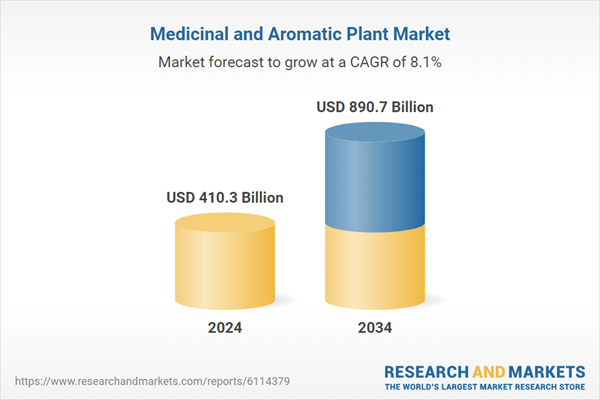Medicinal and aromatic plants are widely used across the pharmaceutical, food and beverage, and cosmetics sectors. In pharma, they act as vital inputs for creating both traditional and modern medicinal formulations. They are also incorporated into flavor systems and nutritional ingredients across the F&B industry. On the cosmetic front, their natural aromatic compounds help develop skincare and wellness products. Advances in extraction technologies, organic cultivation practices, and eco-conscious harvesting have further supported market expansion. The demand remains strongly influenced by consumer preference for clean-label, green, and plant-based alternatives.
In 2024, the medicinal plants segment captured 64.8% share and is forecast to grow at a CAGR of 8% through 2034. Their rising importance stems from their continued use in a range of health systems, from traditional therapies to contemporary supplements and pharmaceuticals. These plants are extensively employed to address inflammation, infections, and chronic illnesses, drawing steady interest from manufacturers and consumers across global markets.
The pharmaceutical sector generated a market value of USD 165.3 billion in 2024 and is anticipated to grow at a faster CAGR of 8.4% over the next decade. As the healthcare sector rapidly evolves to meet growing needs for treatment options, medicinal plants are increasingly integrated into new drug formulations, herbal therapies, and preventative treatments. The sector’s focus on continuous R&D further propels the demand for botanical inputs.
U.S. Medicinal and Aromatic Plant Market accounted for the largest share, valued at USD 82.3 billion in 2024, with expected growth at a CAGR of 6.3% through 2034. Strong agricultural and distribution infrastructure enables reliable supply chains and high-quality output across the medicinal and aromatic plant sector. Consumer preference for herbal, non-synthetic remedies is high, supported by a trusted regulatory environment that assures quality and safety.
Prominent companies shaping the competitive landscape of this market include Forest Essential, Emami Limited, doTERRA International, Givaudan SA, and Dabur India Limited. To secure a competitive edge, companies in the medicinal and aromatic plant market are focusing on vertical integration and investment in organic farming practices. Many are expanding production facilities, partnering with local growers, and enhancing processing capabilities to ensure consistent quality and traceability. They are also leveraging technological advancements in extraction and purification to deliver high-potency plant-based ingredients. Building trust through clean labeling, sustainable sourcing, and transparency in supply chains remains central. Additionally, companies are targeting international markets through customized product lines and strategic collaborations to grow global reach and reinforce their foothold.
Comprehensive Market Analysis and Forecast
- Industry trends, key growth drivers, challenges, future opportunities, and regulatory landscape
- Competitive landscape with Porter’s Five Forces and PESTEL analysis
- Market size, segmentation, and regional forecasts
- In-depth company profiles, business strategies, financial insights, and SWOT analysis
This product will be delivered within 2-4 business days.
Table of Contents
Companies Mentioned
- Dabur India Limited
- doTERRA International
- Emami Limited
- Forest Essentials
- Givaudan SA
- Himalaya Drug Company
- Kama Ayurveda
- Khadi Natural
- Patanjali Ayurved Limited
- Shahnaz Husain
- Symrise AG
- Tongrentang
- Young Living Essential Oils
Table Information
| Report Attribute | Details |
|---|---|
| No. of Pages | 245 |
| Published | July 2025 |
| Forecast Period | 2024 - 2034 |
| Estimated Market Value ( USD | $ 410.3 Billion |
| Forecasted Market Value ( USD | $ 890.7 Billion |
| Compound Annual Growth Rate | 8.1% |
| Regions Covered | Global |
| No. of Companies Mentioned | 13 |









